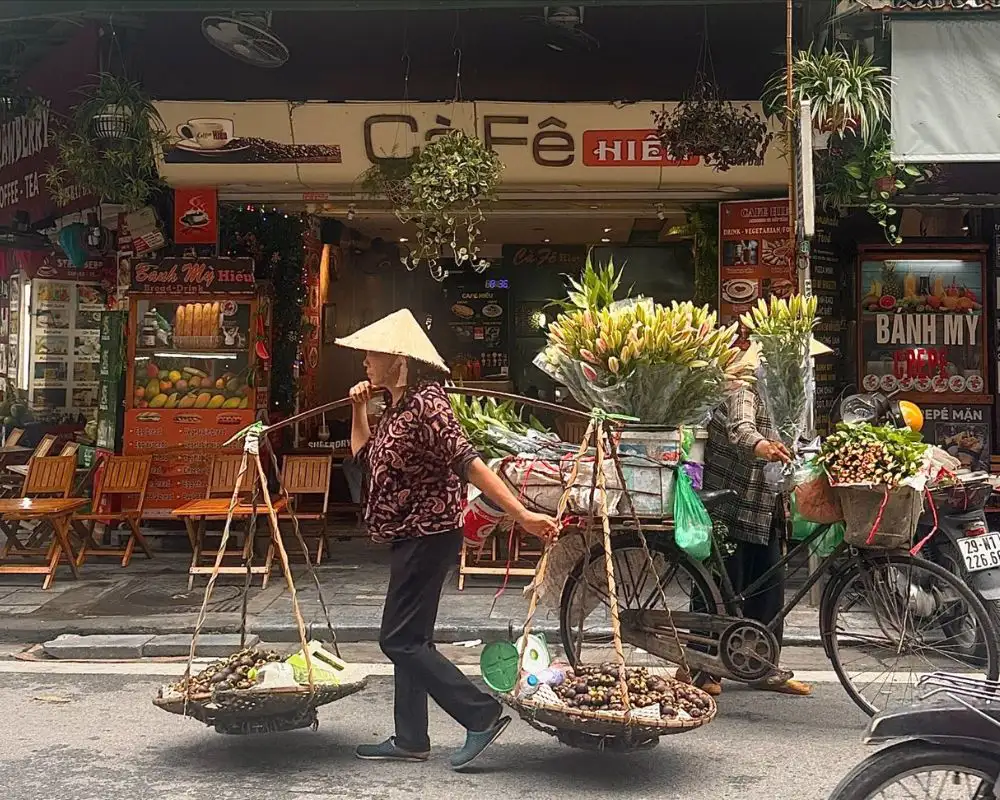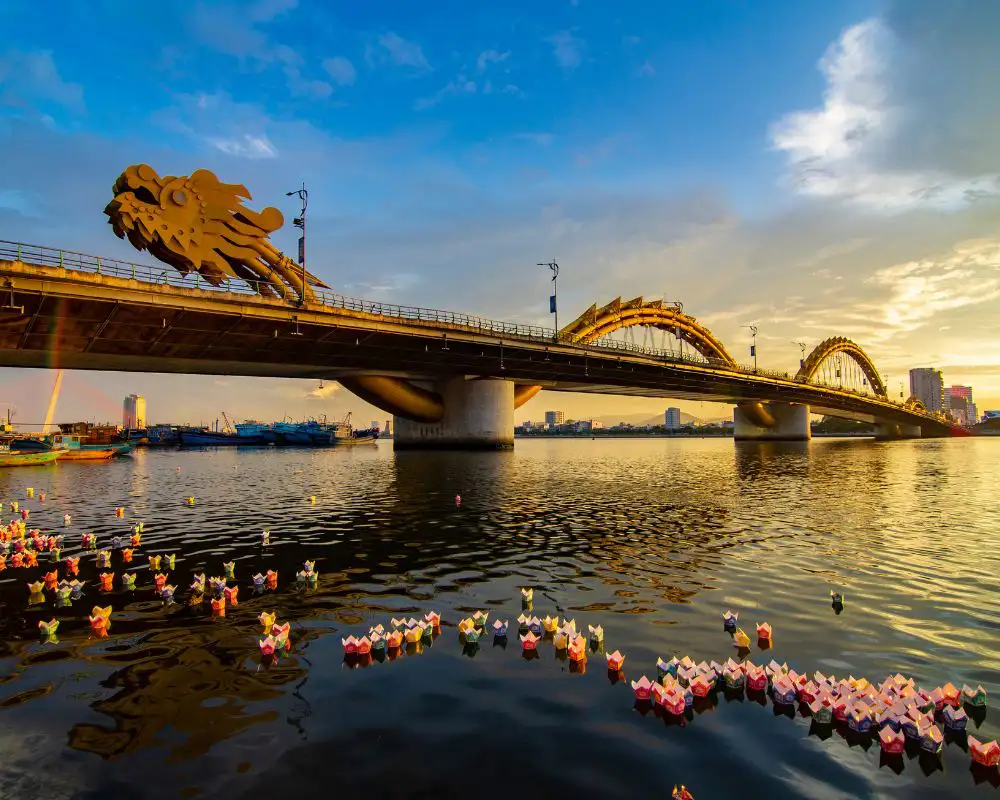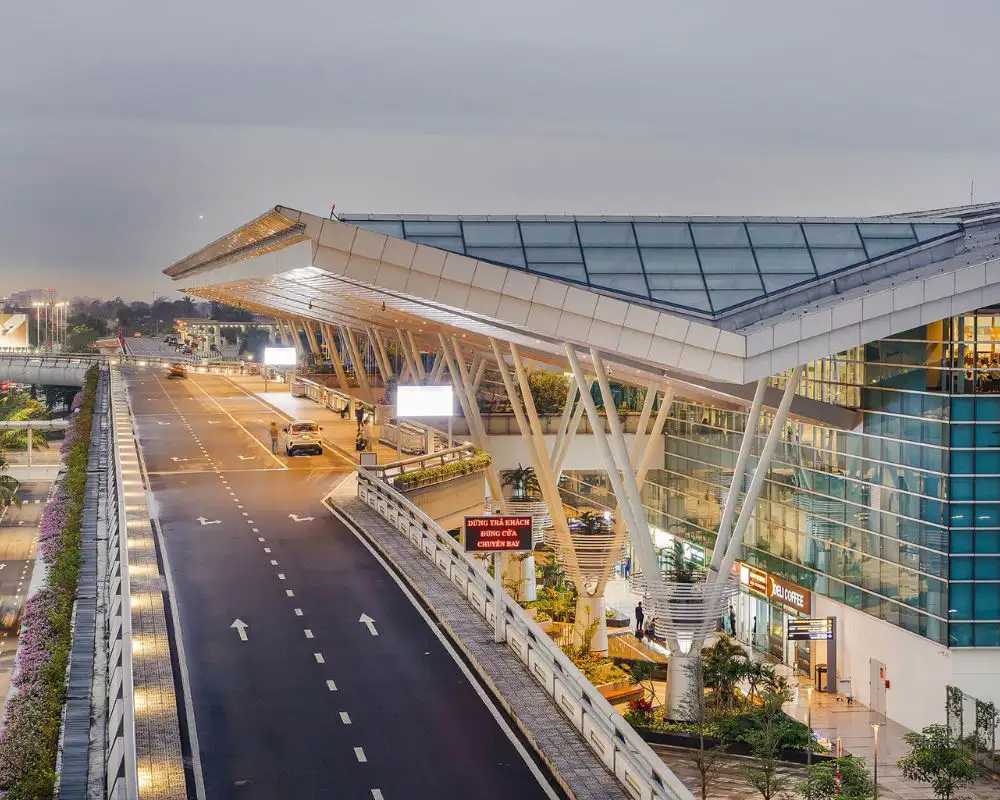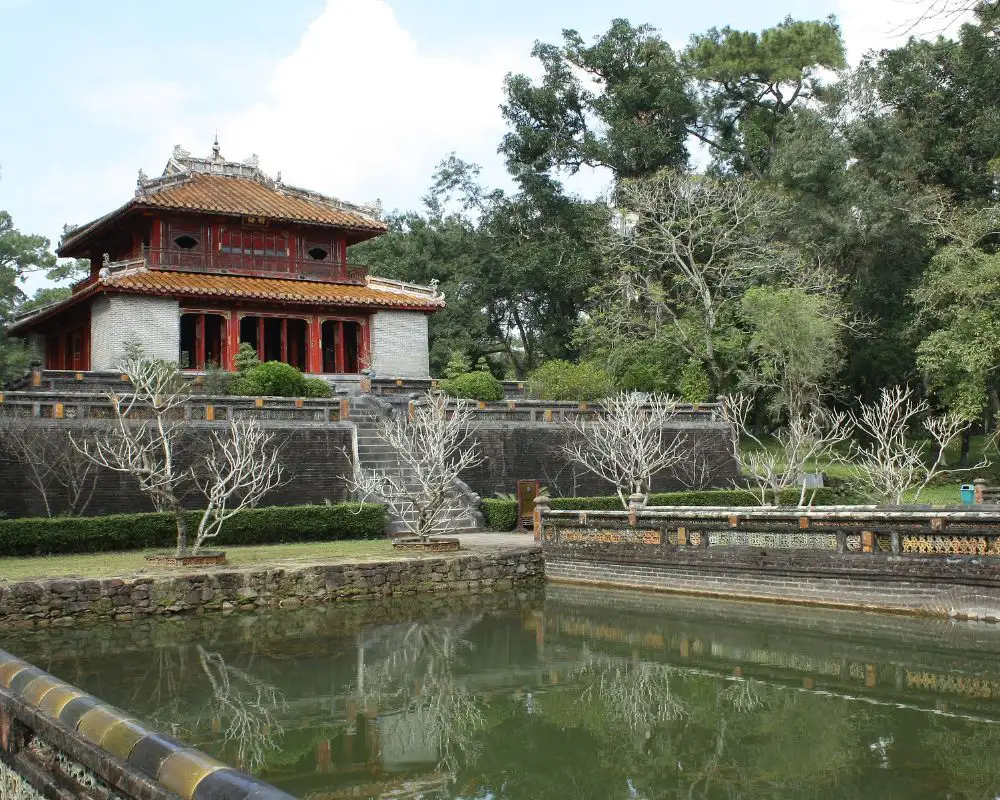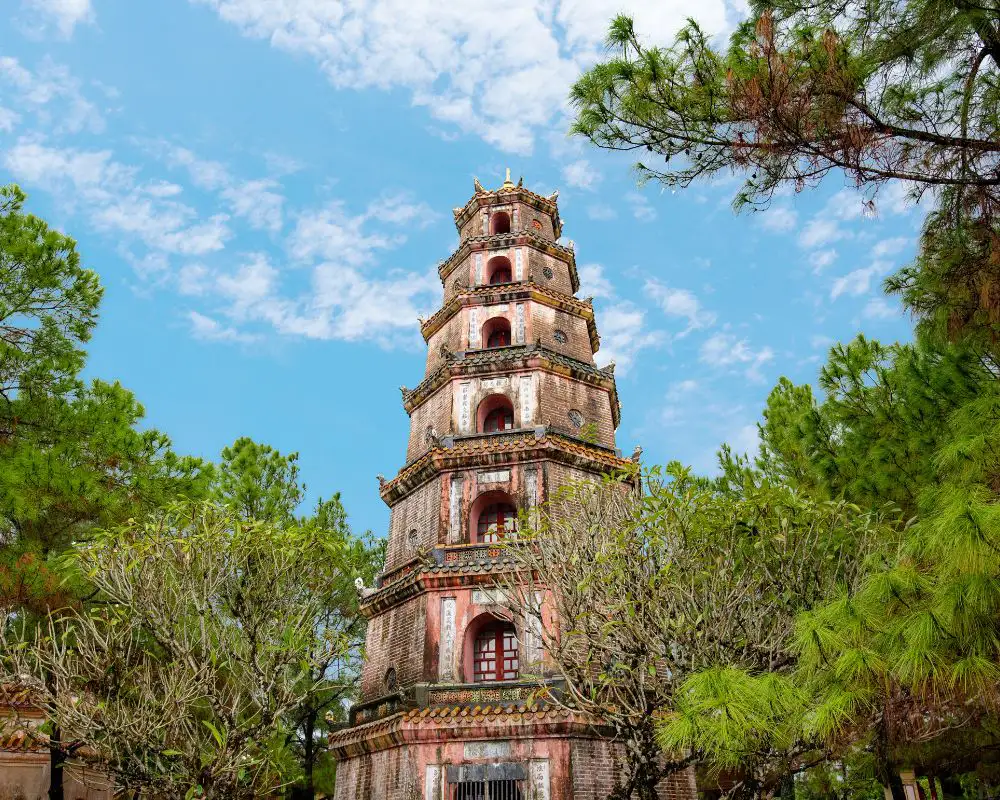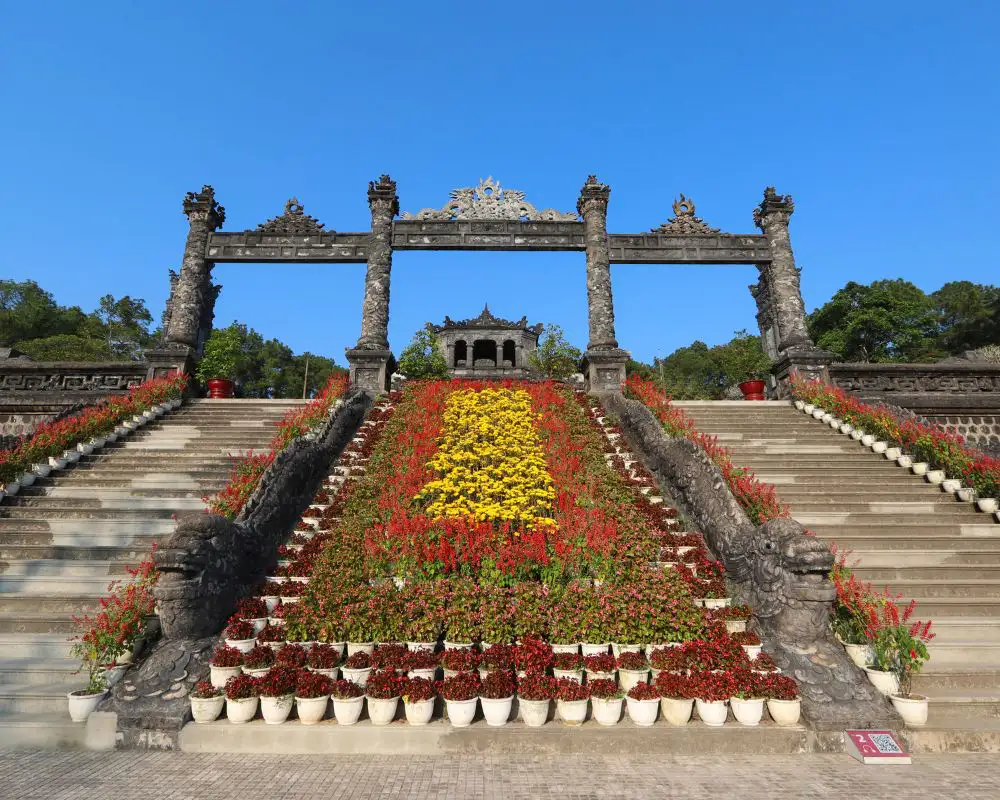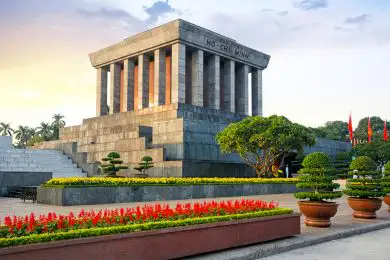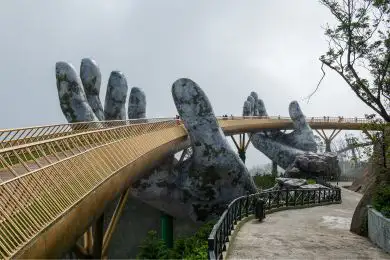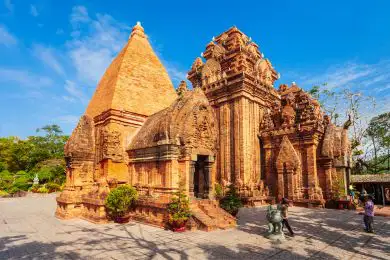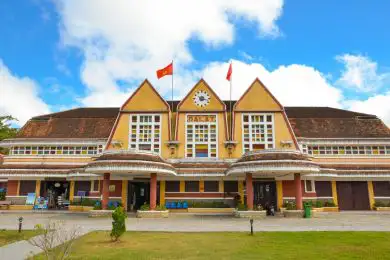This Complete Guide to Marble Mountains Danang aims to provide everything you need to know about it, from its history and geological features to practical tips for visitors. Join us as we delve into the enchanting world of Marble Mountains Danang, exploring its hidden treasures and uncovering the stories that have shaped this remarkable destination.
Introduction to Marble Mountains Danang
Where is Marble Mountain in vietnam? Marble Mountains, known locally as Ngu Hanh Son, are a cluster of five limestone and marble hills in the city of Danang, Vietnam. This iconic destination combines natural beauty with cultural and historical significance, making it a must-visit for travelers. This is The Marble Mountains in Vietnam, a place where history, culture, and natural wonders converge.
- Address: 81 Huyen Tran Cong Chua, Hoa Hai, Ngu Hanh Son, Da Nang
- Opening hours: 7 AM–5 PM daily
- Web: //nguhanhson.org/
- Phone: 02363961114
- Map: //maps.app.goo.gl/8wrBM6N53fP3eYUW9
- Ticket price: 40,000 VND/person; You should use the elevator is 15,000 VND.
History of Marble Mountains Danang
The history of Marble Mountains dates back centuries, reflecting Vietnam’s rich cultural tapestry. The area was originally a spiritual retreat for Mahayana Buddhists and the Cham people. Over time, the mountains have seen various historical events and transformations, including their use as a strategic lookout during wartime and a place of pilgrimage.
The Marble Mountains have ancient roots connected to the Cham civilization, with historical records indicating that the Cham people used the mountains for worship and meditation. The intricate carvings and ancient inscriptions found in the caves speak volumes about the early religious activities.
Throughout the ages, the Marble Mountains have been a significant cultural hub. Vietnamese folklore and legends are deeply intertwined with these hills, adding layers of mystique and reverence to the site. The caves and pagodas have hosted numerous monks and pilgrims over the centuries.
In recent years, the Marble Mountains have become a popular tourist destination. Modern amenities have been introduced to enhance visitor experiences, including improved pathways, guided tours, and informative exhibits. However, the site maintains its historical charm and spiritual ambiance.
Read more: Top Danang best dishes must try
Geography and Geology of Marble Mountains
The Marble Mountains are characterized by their unique geological formations. Comprised primarily of limestone and marble, natural processes have sculpted these hills over millions of years.
The formation of Marble Mountains is attributed to ancient tectonic activities and the gradual erosion by water and wind. These processes have resulted in the creation of stunning caves, grottoes, and unique rock formations.
Each mountain in the cluster is composed of different types of marble and limestone, with colors ranging from white and gray to reddish hues. This geological diversity contributes to the mountains’ distinct appearance and their value as a source of marble for local artisans.
The topography of Marble Mountains is rugged, featuring steep cliffs, narrow pathways, and hidden grottoes. The highest peak, Thuy Son, offers panoramic views of the surrounding area, including the coastline and Danang.
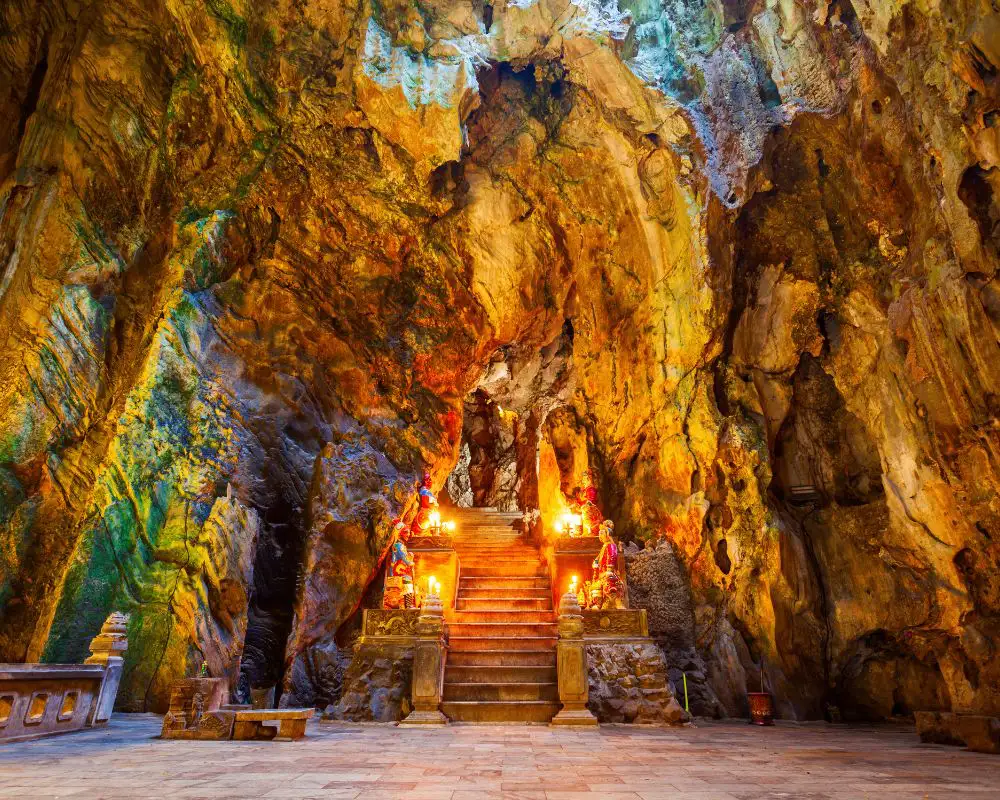
The Five Mountains
The Marble Mountains are named after the five elements of the ancient oriental philosophy: Water, Wood, Fire, Metal, and Earth. Each mountain has its own unique characteristics and attractions.
Thuy Son (Water Mountain)
Thuy Son is the largest and most visited of the five mountains. It is home to numerous caves, pagodas, and viewpoints. Key attractions include the Linh Ung Pagoda, Huyen Khong Cave, and the Heaven Gate viewpoint. For those Discovering The Enchanting Marble Mountains Danang, Thuy Son is an essential stop.
Moc Son (Wood Mountain)
Moc Son is known for its lush greenery and serene ambiance. Although less developed than Thuy Son, it offers peaceful trails and beautiful natural scenery. Local legends and myths add to the mystique of Moc Son.
Hoa Son (Fire Mountain)
Hoa Son is split into two peaks and features several ancient temples and pagodas. The mountain provides a breathtaking view of Da Nang and has significant historical sites that attract history enthusiasts.
Kim Son (Metal Mountain)
Kim Son is celebrated for its cultural and religious importance. It hosts various festivals throughout the year and is known for its hidden caves and historical relics. The mountain is also associated with local legends and folklore.
Tho Son (Earth Mountain)
Tho Son is the least visited but offers a raw, natural beauty. It is ideal for hiking and exploration, with numerous trails leading to secluded spots and scenic viewpoints. This mountain is perfect for those seeking tranquility and a closer connection to nature.
Famous Caves of Marble Mountains
The caves of Marble Mountains are among its most captivating features. Each cave holds its own story and charm, offering visitors a glimpse into the past and the natural artistry of the mountains.
Huyen Khong Cave
Huyen Khong Cave is renowned for its mystical atmosphere and stunning rock formations. It has been a place of worship for centuries and continues to be a spiritual retreat for visitors.
The cave’s interior is illuminated by natural light filtering through holes in the cave ceiling, creating a serene and almost otherworldly ambiance. Stalactites and stalagmites of various shapes and sizes add to the cave’s natural beauty.
Huyen Khong Cave is also home to several altars and Buddha statues, making it a significant site for religious practices. The tranquility and spiritual energy of the cave make it a favorite spot for meditation and reflection.
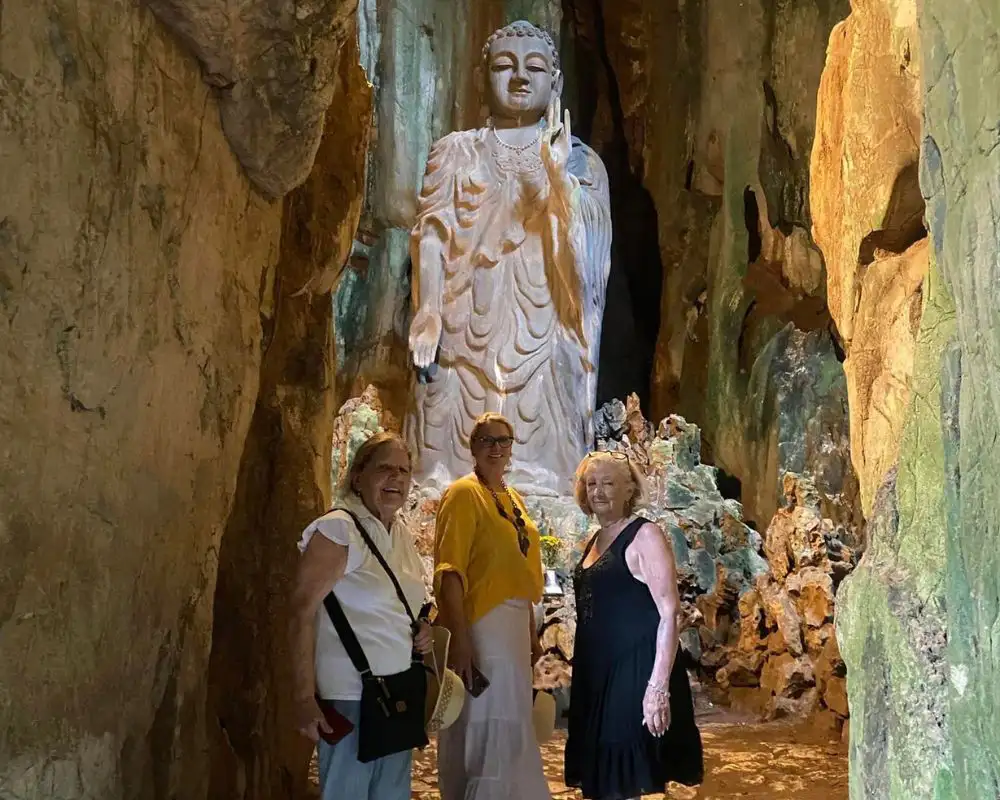
Am Phu Cave
Am Phu Cave, also known as Hell Cave, provides a dramatic exploration experience with its dark passages and intricate carvings depicting scenes from the afterlife. It is a popular spot for adventurous visitors.
The cave’s name and design are inspired by Buddhist concepts of hell, with carvings and statues illustrating the punishments that await wrongdoers in the afterlife. Despite its somewhat eerie theme, the cave offers a fascinating and unique experience.
Exploring Am Phu Cave requires navigating through narrow, winding passages and steep steps, adding an element of adventure. The cave is well-lit in areas to highlight its dramatic features, but a flashlight can help explore the darker sections.
Linh Nham Cave
Linh Nham Cave is known for its serene beauty and tranquil environment. It features natural stalactites and stalagmites, creating a picturesque underground landscape.
This cave is less frequented by tourists, offering a peaceful retreat for those looking to escape the crowds. The cool, damp atmosphere and the sound of dripping water create a calming environment perfect for quiet contemplation.
Linh Nham Cave also houses several small shrines and altars, adding to its spiritual significance. Visitors can spend time exploring the cave’s various chambers and admiring the natural rock formations.
Pagodas and Temples at Marble Mountains Danang
Marble Mountains are dotted with numerous pagodas and temples, each with its own historical and spiritual significance.
Linh Ung Pagoda
Linh Ung Pagoda is one of the most prominent religious sites on Thuy Son. This impressive structure is perched on a hill, offering breathtaking views of the surrounding area, including the city of Da Nang and the South China Sea. The pagoda is home to several significant Buddha statues, including a large, intricately carved marble Buddha that draws numerous visitors and pilgrims.
The pagoda’s architecture is a blend of traditional Vietnamese and contemporary styles, with intricately designed gates, serene courtyards, and beautifully landscaped gardens. Visitors often spend time in quiet contemplation or engage in prayer within the tranquil environment.
Tam Thai Pagoda
Tam Thai Pagoda is one of the oldest and most revered temples in Marble Mountains. Built in the 17th century, it has a rich history tied to the region’s spiritual and cultural development. The pagoda’s architecture features traditional Vietnamese elements, including curved roofs, ornate carvings, and colorful decorations.
The pagoda consists of three main buildings, each representing one of the three jewels of Buddhism: the Buddha, the Dharma (Buddhist teachings), and the Sangha (Buddhist community). The serene surroundings, combined with the site’s spiritual significance, make Tam Thai Pagoda a popular spot for worship and tourism.
The path to the pagoda involves climbing a series of stone steps, offering scenic views of the lush landscape and the other Marble Mountains along the way. This journey adds to the spiritual experience, making the pagoda a highlight for many visitors.
Quan Am Pagoda
Quan Am Pagoda is dedicated to the Goddess of Mercy, Quan Am (also known as Guanyin or Avalokitesvara), who is highly revered in Vietnamese Buddhism. The pagoda is nestled among trees and natural rock formations, providing a peaceful retreat for meditation and reflection.
The main hall of Quan Am Pagoda houses a statue of the Goddess of Mercy, surrounded by intricate murals and altars filled with offerings from devotees. The serene atmosphere and the gentle sounds of nature create an ideal setting for spiritual practice.
The pagoda also features several smaller shrines and altars dedicated to various Buddhist deities and historical figures. Visitors can explore these areas while enjoying the natural beauty and tranquility of the surroundings.
How to get to Marble Mountains?
Located approximately 11 kilometers from the vibrant city center of Da Nang, Vietnam, the Marble Mountains offer a convenient and captivating addition to your travel plans. From the city center, several transportation options are available. One way is to take a taxi or a ride-hailing service directly to the site, which typically takes about 30 minutes, depending on traffic conditions.
Alternatively, you can use public transportation by catching a local bus. Visitors can easily find the designated bus stops and inquire about the specific bus routes leading to the Marble Mountains.
For those seeking a more adventurous and immersive experience, renting a bicycle or motorbike can be an enjoyable way to reach the destination. This option allows travelers to explore the picturesque scenery along the way. No matter which mode of transportation you choose, the journey to the Marble Mountains promises a captivating experience amidst the site’s natural beauty and cultural significance.
If you are traveling from Hoi An, a short 20-kilometer drive north will lead you to a prominent sign that unmistakably marks the entrance to the Marble Mountains.
What places are near the Marble Mountains?
Combine your visit to Marble Mountains with other nearby attractions such as My Khe Beach, Hoi An Ancient Town, and the Dragon Bridge in Danang.
- My Khe Beach, known for its white sands and clear waters, is just a short drive from Marble Mountains and offers a perfect spot to relax after exploring the mountains.
- Hoian Ancient Town, a UNESCO World Heritage Site, is also nearby and provides a fascinating glimpse into Vietnam’s historical and cultural past. Read more: How Can Get From Danang to Hoian
- The Dragon Bridge in Danang is another must-see attraction, especially at night when the bridge lights up and performs a dragon show with fire and water. Combining these attractions with a visit to Marble Mountains makes for a comprehensive and enjoyable travel experience in the region.
Shopping in Marble Mountains
Marble Mountains is famous for its marble handicrafts and souvenirs. Visitors can find a variety of items made from the local marble, including statues, jewelry, and household items.
Local artisans create beautiful marble statues and carvings that make for unique souvenirs. These items are available in various sizes and styles, from small trinkets to large sculptures.
In addition to marble items, visitors can find a range of other souvenirs, including traditional Vietnamese clothing, accessories, and handicrafts.
Besides, the local markets near Marble Mountains offer a variety of goods, including fresh produce, spices, and handmade crafts. These markets provide an opportunity to experience the local culture and pick up some unique items.
Read more: Ba Na Hills Golden Bridge
Visitor Tips and Guidelines
To make the most of your visit to Marble Mountains, consider these practical tips and guidelines.
Best Time to Visit
The best time to visit Marble Mountains is during the dry season, from February to May. The weather is pleasant, making it ideal for exploration.
During these months, temperatures are moderate, and there is less rainfall, making it easier to explore the outdoor attractions and hike the trails. The clear skies also provide excellent conditions for photography and sightseeing.
Safety Tips
Wear comfortable footwear as the terrain can be uneven. Stay hydrated and be cautious of your surroundings, especially when exploring the caves and narrow pathways.
The pathways in Marble Mountains can be steep and slippery, especially after rain. It is advisable to wear sturdy shoes with good grip to navigate the trails safely. Bring plenty of water, as the climbing and walking can be physically demanding, especially in the heat.
When exploring the caves, watch your step and be mindful of low ceilings and narrow passages. Some caves may be dark, so a flashlight can be useful. Always follow the designated paths and respect any signage or instructions from guides.
For a more enjoyable visit to the Marble Mountains, you can contact tour companies such as Vietnam Trails Travels, which offer combined tours that include exploring the Marble Mountains.
We offer combined tours that include not only exploring the Marble Mountains but also other nearby attractions. By choosing a tour package, you can benefit from the expertise of local guides, seamless transportation, and a well-organized itinerary that ensures you experience the best of what the Marble Mountains and surrounding areas have to offer. This hassle-free approach allows you to fully immerse yourself in the natural beauty and cultural significance of the region.
Some our Danang tours that you can refer to:



